|
|
Created/dedicated as per personal communication with Kevin P., (Agrius cingulata), October 19, 2010
Updated as per James P. Tuttle's The Hawk Moths of North America, October 19, 2010
Updated as per Butterflies and Moths of North America, formerly USGS, October 19, 2010
Updated as per personal communication with Lee Gosset (Ceratomia undulosa; Eumorpha achemon), September 10, 2012
Updated as per personal communication with Alicia White (Eumorpha achemon), August 31, 2016
Updated as per personal communication with Cindy Casey (Manduca rustica, Oklahoma City, Oklahoma County, October 2, 2018), October 3, 2018
|
Oklahoma County, Oklahoma, and other North Central Counties:
Canadian, Grant, Lincoln
Sphingidae
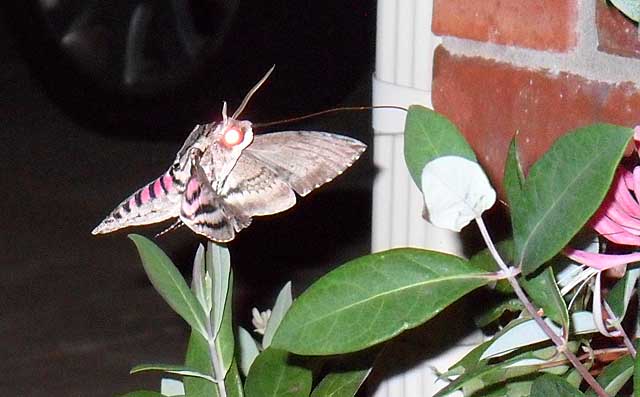
Agrius cingulata, Oklahoma City, Oklahoma County, Oklahoma,
October 18, 2010,
courtesy of Kevin P.
This page is inspired by and dedicated to Kevin P. who sent me the image of Agrius cingulata at the top of the page.
Kevin writes, "First and foremost, you have a very interesting and informative website. I think (with the help of a friend of mine at Stanford and your
website) that a species I observed might be Hyles lineata, but I'm not sure.
"The story: I live in Oklahoma City. I've got flowering vines right off of my front porch, where there is a porch light and landscape lights.
Tonight, at approx 11:00pm, I observed a large moth (thought it was a hummingbird at first) fluttering around the vines. So I snapped some pictures.
I attached one, only because the image files are so big. If you'd like to see more, I'll send what I have.
"Is this, in fact, a white lined sphinx moth? Let me know what you think."
Kevin has the correct family of moths: Sphingidae, and both the White-lined Sphinx (Hyles lineata) and Agrius cingulata have pinkish
hindwings, but this one is the Pink-spotted Hawkmoth, Agrius cingulata.
As far as I know, larvae of this species have not been recorded in Oklahoma, so the moth would be an adult stray from further south where winters are not
quite so cold. I have seen larvae from Dallas area of northeastern Texas, but that is about as far north as they are found in south central US.
The adult Sphingidae are very strong fliers, and most of them nectar from flowers open at night. They also tend to be attracted to lights.
Some of the strays from further south are most likely to be seen in the fall, and there northward flights may be aided by hurricane or strong winds
from the south.
Thirty-seven Sphingidae species are listed for Oklahoma on the USGS checklist. Not all of the species are reported or anticipated in
Oklahoma County (four on USGS as of october 19, 2010).
It is hoped that this checklist, with the thumbnails and notes, will help you quickly identify the moths you have encountered.
A "WO" after the species name indicates that I have no confirmed reports of this species in Oklahoma County,
but I (William Oehlke) expect that this moth is present or might be present.
A USGS indicates the moth is reported on the USGS website and/or in Moths of Western North America,
#2. Distribution of Sphingidae of Western North America, revised,
an excellent little booklet available through Paul Opler.
Please help me develop this list with improved, documented accuracy by sending sightings (species, date, location), preferably with an
image, via email to Bill Oehlke.
Many thanks to Lee Gosset who confirms Ceratomia undulosa and Eumorpha achemon in Oklahoma County.
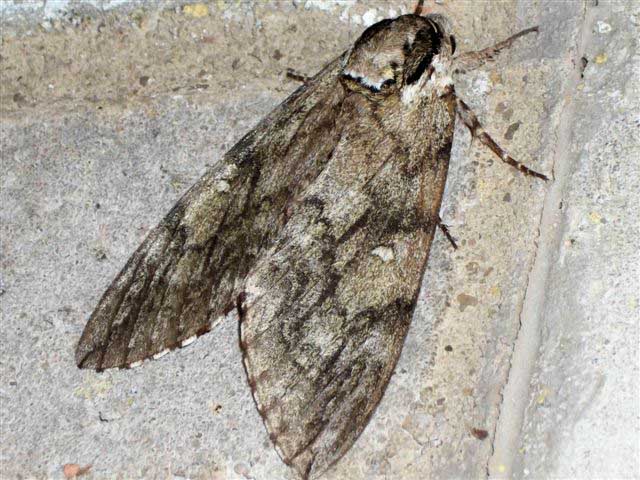
Ceratomia undulosa, Oklahoma City, Oklahoma County, Oklahoma,
September 10, 2012, courtesy of Lee Gosset.
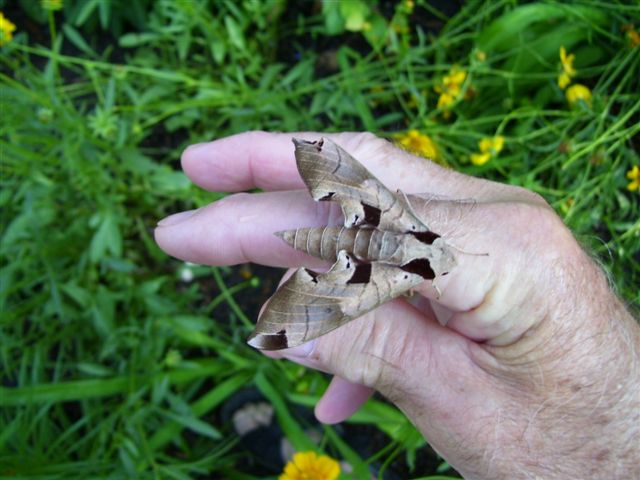
Eumorpha achemon, Oklahoma City, Oklahoma County, Oklahoma,
May 27, 2011, courtesy of Lee Gosset.
Many thanks to Alicia White who provides the following image of Eumorpha achemon.
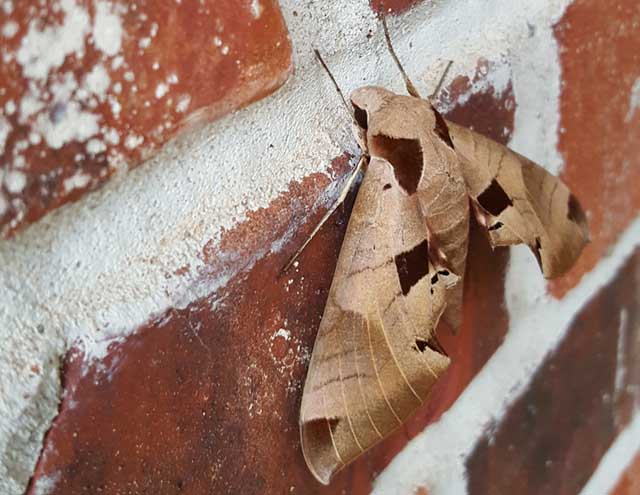
Eumorpha achemon. Oklahoma City, Oklahoma,
August 30, 2016, courtesy of Alicia White.
Many thanks to Cindy Casey who sends this image (Trisha Montgomery photo) of Manduca rustica, a first for Oklahoma County.

Manduca rustica, southern Oklahoma City, Oklahoma County, Oklahoma,
October 2, 2018, courtesy of Trisha Montgomery, via Cindy Casey.
Although this page was originally intended to cover only Oklahoma County, it is likely valid for the nearby counties of
Canadian, Grant, Lincoln. Species confirmed by BAMONA for those counties are listed below.
Canadian (4): Manduca rustica; Sphinx vashti; Hemaris diffinis; Hyles lineata
Grant: none recorded as of October 3, 2018
Lincoln (5): Agrius cingulata; Manduca sexta; Amorpha juglandis; Hemaris diffinis; Deidamia inscriptum.
Visit Oklahoma County Sphingidae larvae Checklist.
Visit Oklahoma Catocala, Underwing Moths.
Visit Sphingidae of the Americas for checklists of all North, South and Central American countries.
Sphinginae subfamily
Sphingini tribe:
 |
Agrius cingulata
KP, probably a stray/Lincoln.
A strong migrant; adults nectar from deep-throated
flowers including moonflower (Calonyction aculeatum), morning
glory (Convolvulus), honey suckle (Lonicera) and
petunia (Petunia species).
|
Agrius cingulata, Oklahoma City, October 18, 2010, Kevin P.
 |
Ceratomia amyntor
WO,
the Elm Sphinx or Four-horned Sphinx.
Forewing is brown with dark brown and white
markings including a white costal area near the wing base, dark
streaks along the veins, and a white spot in the cell.
Larvae feed on Elm (Ulmus), birch (Betula), basswood (Tilia), and cherry (Prunus). |
 |
Ceratomia catalpae
WO, generally more easterly,
Catalpa Sphinx.
Fw upperside is yellowish brown with no white
markings, but there are indistinct black lines and dashes. The cell
spot is gray with a black outline and the upperside of the hindwing
is yellowish brown with obscure lines. Larvae feed in large
groups and are much more spectacular than the moths. Catalpa is
the larval host. |
 |
Ceratomia undulosa
WO/LG, Waved
Sphinx.
Forewing is pale brownish gray with wavy black
and white lines and a black-outlined white cell spot.
|
Ceratomia undulosa, Oklahoma City, September 10, 2012, courtesy of Lee Gosset.
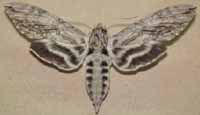 |
Lintneria eremitoides
WO,
the Sage Sphinx.
Look for two thin black dashes across a slightly darker median patch in an
otherwise distinct, light median area.
possibility |
 |
Manduca quinquemaculatus
WO, Five-spotted Hawkmoth.
Abdomen usually has five but sometimes six pairs of yellow
bands. Fw: blurry brown and gray.
Larvae feed on tomatoes and go by the common name of
"Tomato Hornworms". |
 |
Manduca rustica
Cindy Casey/Canadian, the Rustic Sphinx
Look for three large yellow spots
on each side of the abdomen. The upperside of the forewing is
yellowish brown to deep chocolate brown with a dusting of white
scales and zigzagged black and white lines.
|
Manduca rustica adult, Oklahoma City, Oklahoma County, October 2, 2018, Cindy Casey
 |
Manduca sexta
Oklahoma/Lincoln, Carolina Sphinx.
The abdomen usually has six pairs of yellow bands, broken across the
back. The sixth set of markings is quite small.
The upperside of the forewing has indistinct black, brown and
white markings.
If you grow tomatoes, you have probably encountered it. |
 |
Paratrea plebeja
WO, Plebeian Sphinx.
Forewing is gray with indistinct black and
white markings. There is a series of black dashes
from the base to the tip, and a small white cell spot.
|
 |
Sphinx chersis
Oklahoma, Northern Ash Sphinx/ Great Ash
Sphinx. Forewing is soft dark gray to
blue-gray with a series of black dashes, one of which reaches the
wing tip. Larval hosts are ash, lilac, privet, cherry, and quaking aspen.
|
 |
Sphinx drupiferarum
WO,
Wild Cherry Sphinx.
Sphinx drupiferarum larvae hide in the day and feed primarily on
cherry, plum, and apple at night.
possibly |
 |
Sphinx vashti
Oklahoma/Canadian, Snowberry Sphinx
Forewing has a narrow black subterminal line
bordered by a white inverted V-shaped line on the outside, and a
black line running inwards from the apex of the wing.
It is most often found in montane woodlands and along streamcourses. |
Smerinthini Tribe:
 |
Amorpha juglandis
WO/Lincoln,
the Walnut Sphinx.
The adults are also highly variable; sometimes wings of an individual
may be all one color or may have several colors, ranging from pale to
dark brown, and may have a white or pink tinge.
See the file for the female; she is different. |
 |
Pachysphinx modesta
WO,
the Modest Sphinx or Poplar Sphinx.
This moth has a large, heavy body, and females
can be remarkably plump.
|
 |
Paonias excaecata
WO, generally more easterly, Blinded Sphinx.
The grey-blue eyespot of the hindwing gives this species its name.
Larvae feed on birches, willows, cherries and oaks.
The outer edge of the forewings is quite scalloped. |
 |
Paonias myops WO, generally more easterly,
the Small-eyed Sphinx.
This small species is probably widespread and common. This species ranges across North America.
The hindwings have a small blue eyespot ringed with black on a yellow background.
|
 |
Smerinthus jamaicensis
WO, the Twin-spotted Sphinx.
Smerinthus jamaicensis closely resembles Smerinthus cerisyi, but
jamaicensis is much smaller with larger blue patches on
more vibrant and deeper purple in the lower wings.
|
Macroglossinae subfamily
Dilophonotini tribe
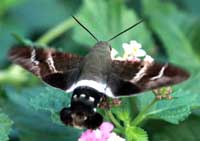 |
Aellopos titan
WO, unlikely, Titan Sphinx.
Body: dark brown with wide white stripe across abdomen.
Wings: dark brown. It is very similar to above species, but
the upperside of the hindwing has pale patches along the costa and
inner margin. very rare stray |
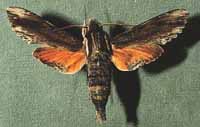 |
Erinnyis domingonis
WO, unlikely , the Dominican Sphinx.
This moth flies in Haiti and Jamaica south to Paraguay and Bolivia
with occasional sightings in Texas and Arizona. This species
might be present in Pottawatomie County as a
very rare stray.
|
 |
Erinnyis ello, the Ello Sphinx,
WO, unlikely.
The abdomen has very distinct gray and black bands.
Adults nectar at dusk so you may see them in the garen at that
time, but only as very rare strays. |
 |
Erinnyis obscura, the Obscure Sphinx,
WO, unlikely.
During the night adults nectar at flowers, including bouncing bet
(Saponaria officinalis) and Asystasia gangetica beginning at dusk.
July and August are flight times in the southern states. very rare strays
|
 |
Hemaris diffinis WO/Canadian/Lincoln,
Snowberry Clearwing/Bumblebee Moth.
The wings are basically clear, with dark brown to brownish-orange
veins, bases and edges. The thorax is golden-brown to dark
greenish-brown. The abdomen tends to be dark (black) with 1-2 yellow
segments just before the end. |
 |
Hemaris thysbe
WO, generally more easterly, the Hummingbird Clearwing.
It is not difficult to see why many gardeners would mistake an
Hemaris thysbe moth for a small hummingbird as it hovers, sipping
nectar from flowers through a long feeding tube.
|
Philampelini tribe:
 |
Eumorpha achemon
WO/LG/AW,
Achemon Sphinx.
Adults nectar from flowers of Japanese honeysuckle
(Lonicera japonica), petunia (Petunia hybrida),
mock orange (Philadelphus coronarius), and phlox (Phlox).
Larvae feed upon Grape (Vitis),
Virginia Creeper (Parthenocissus quinquefolia),
other vines, ivies (Ampelopsis).
|
Eumorpha achemon, Oklahoma City, May 27, 2011, courtesy of Lee Gosset.
Eumorpha achemon, Oklahoma City, August 30, 2016, courtesy of Alicia White.
 |
Eumorpha fasciatus
CG, the Banded Sphinx.
This moth is a very strong flier and is often reported far north of
its normal range.
It would be a rare stray to Pottawatomie
(Shawnee, August 31, 2005)
|
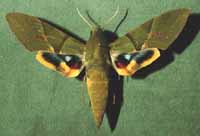 |
The Gaudy Sphinx flies in America, and although primarily a tropical
species, it has been taken as far north as Saskatchewan as a stray.
Forewings are a vibrant grey-green. unlikely stray from further south
|
 |
Eumorpha pandorus
WO, the Pandorus Sphinx.
If you have Grape or Virginia Creeper nearby, then you probably have
this species.
|
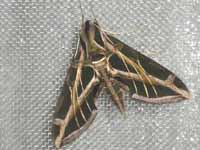 |
Eumorpha vitis
WO, possible stray from further south,
the Vine Sphinx.
The upperside of the moth is dark pinkish brown. Each forewing has a
lighter brown band along the costa, and sharp pinkish white bands and
streaks. The hindwing has a pink patch on the inner margin.
|
Macroglossini tribe
 |
Amphion floridensis
WO,
the Nessus Sphinix.
This day flier is widely distributed. If you have Virginia Creeper, you
probably have the Nessus Sphinx. It is reported from
Hunterdon. Two bright, distinct, narrow yellow
bands are often visible on the abdomen.
|
 |
Darapsa choerilus
WO, generally more easterly, the Azalea Sphinx.
The lower wings of this hawkmoth are a solid brownish-orange,
matching the body colour.
You will often see this species listed as Darapsa pholus,
especially in older literature.
|
 |
Darapsa myron
WO, Virginia Creeper Sphinx/Grapevine Sphinx.
Forewing: dark brown to pale yellowish gray, with an olive tint.
On costal margin there is dark rectangular patch, although this may be reduced or absent.
Hw upperside is pale orange. |
 |
Deidamia inscriptum
WO/Lincoln,
the Lettered Sphinx.
The moth's outer margin of the forewing is deeply scalloped.
The upperside is light brown with dark brown markings.
There is a small black and white spot near the tip.
The upperside of the hindwing is orange-brown with a dark brown outer margin and median line.
|
 |
Hyles lineata Oklahoma/Canadian, White-lined Sphinx.
This species is very widespread. It can be seen flying during the day,
into the evening and also at night.
The highly variable larvae are often found in people's gardens. |
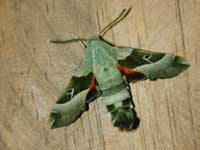 |
Proserpinus juanita
WO,
the Juanita Sphinx.
The upperside of the forewing is pale gray-green with a deep
green-brown median area and a white dash at the wing tip. The
underside of the forewing is pale orange at the base.
|
 |
Xylophanes tersa
WO, generally more easterly,
the Tersa Sphinx.
The upperside of the forewing is pale brown with lavender-gray at the
base and has dark brown lengthwise lines throughout. The upperside of
the hindwing is dark brown with a band of whitish, wedge-shaped
marks.
|
|
|
This website has been created and is maintained by Bill Oehlke without government or institutional financial assistance. All expenses, ie., text reference
support material, webspace rental from Bizland, computer repairs/replacements, backups systems, software for image adjustments (Adobe Photoshop; L-View),
ftp software, anti-virus protection, scanner, etc. are my own.
I very much appreciate all the many images that have been sent to me, or of which I have been granted permission to copy and post from other websites.
All images on this site remain the property of respective photographers.
If you would like to contribute to the maintenance of this website by sending a contribution to
Bill Oehlke
Box 476
155 Peardon Road
Montague, Prince Edward Island, C0A1R0
Canada
your donation would be much appreciated and would be used for
1) paying for webspace rental;
2) paying for computer maintenance and software upgrades;
3) purchases of additional text reference material (journals and books) in anticipation of expanding the site to a worldwide Sphingidae site;
4) helping to pay my daughter's tuition (completed spring of 2013); with anything left over going to humanitarian aid.
If you are mailing a check from USA, please use $0.85 postage ($1.25 is 2018 rate). Donations can also be made through Paypal via the button below.
Enjoy some of nature's wonderments, giant silk moth cocoons.
These cocoons are for sale winter and fall. Beautiful Saturniidae moths will emerge the following spring and summer.
Read Actias luna rearing article.
Additional online help available. Eggs of many North American species are offered during the spring and summer. Occasionally
summer Actias luna and summer Antheraea polyphemus cocoons are available. Shipping to US destinations is done
from with in the US.
Use your browser "Back" button to return to the previous page.
This page is brought to you by
Bill Oehlke and the
WLSS. Pages are on space rented from Bizland. If you would like
to become a "Patron of the Sphingidae Site", contact Bill.
Please send sightings/images to Bill. I will do my best to respond to requests for identification help.
 | 
Show appreciation for this site by clicking on flashing butterfly to the left.
The link will take you to a page with links to many insect sites. |









































